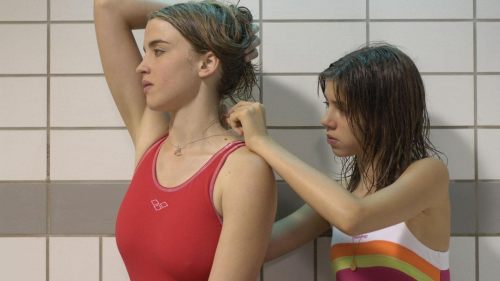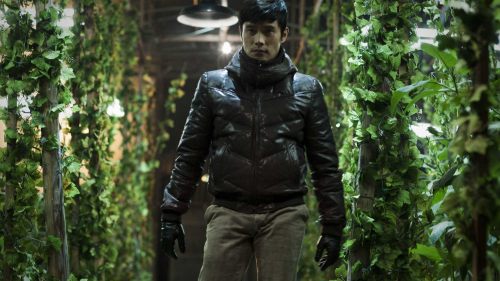Love And Observation In PORTRAIT OF A LADY ON FIRE
Portrait of a Lady on Fire is widening its release this week. Get your tickets here!
Marianne has been hired to watch. Well – she’s been hired to paint a portrait of Héloïse so that Héloïse can be married off to an unknown man in Milan, but Héloïse refused to pose for the last painter. Instead, Marianne poses as Héloïse’s companion for walks, stealing as many glances as she can by day in order to paint her at night.
So Marianne looks. But Héloïse turns around and looks right back at her with the same studied intensity, and in the space between them, something profound and intimate begins to bloom.
What is the difference between art and love, Portrait of a Lady on Fire asks? In the middle of the film, Héloïse reads the story of Orpheus and Eurydice aloud to Marianne and to Sophie, the servant, by candlelight. Héloïse and Marianne debate why Orpheus turned around – is it because he wanted to look at Eurydice as a poet, preserving the story, and her memory, over the woman herself? Or is it because she called out to him?
What is the difference between looking at someone as a poet and as a lover? As it turns out, there is only one. An artist watches their subject, but a lover’s gaze is turned back on them.
Observation is the first step in creation – in building a work of art – and the film reflects this in its empty stretches of space and sound, especially at the beginning. The music is minimal, so when we hear it, it always carries emotional weight. The images, as well, build as the film does, crowding the frame with more characters at a time. Observation is also the first step to falling in love, but it cannot be complete until it is returned.
A lot of films focus on the fact that, when you make art about a person, it creates a facsimile of them – a shadow that can never really measure up to the person themselves. Portrait is aware of this convention; you can never really know someone well enough to render them exactly. There will always be mistakes. But in the film, this kind of mimicking isn’t a betrayal; it’s an act of love, especially in the smallest, most hidden pieces. Héloïse’s official portrait is made for public consumption, commissioned so that Héloïse can be given away to someone else. But the film is also littered with private works of art that are only intended for one person to ever see – Marianne makes personal sketches in books and in lockets; Sophie, the servant, embroiders her own clothing with flowers; Héloïse reads aloud for the two of them. In Portrait, making art does not mean creating something entirely new; it affirms the existence of beauty. It can never capture the full breadth of the experience it’s depicting, but it can bear witness to the fact that the experience took place.
And if art is an act of love, Portrait shows us that the reverse is also true. “Do all lovers feel like they’re inventing something?” Héloïse asks. But unlike the mimic of portraiture, the push and pull of her relationship with Marianne does create something entirely new – a romance where they are both allowed to be equal players. Love becomes an act of art with the two of them as co-collaborators. The process changes them both; just as a painting makes small changes in the subject, love leaves them different than it found them.
The most interesting part of this concept, though – art as love, and love as art – comes when we take a step back from the film itself to evaluate our own role in it as the audience. A film about watching and being watched forces us to ask ourselves, as the viewers, if we are creating something new when we experience it, too.
Marianne watches Héloïse as an artist first, trying to maintain a one-way line of sight. But when Héloïse turns back to study her, too, they can begin to nurture love between them. When we watch a movie, or read a book, or listen to a song, this seems like a relationship that can only flow in one direction – audience to art. But Portrait of a Lady on Fire is a film that watches you back. It takes its time with its visuals and with its sound, but instead of pushing us away, these empty spaces draw us into the film itself, placing us by the ocean or at the kitchen table. And there are so many shots from Marianne’s point of view that we begin to realize that we are watching Héloïse exactly the way Marianne is. When Héloïse’s eyes snap back to Marianne, they look right through the camera and meet our eyes, too. When Héloïse tells Marianne to look as something unfolds, and the camera pans around, she’s calling us to bear witness, as well.
In allowing us to watch, and turning our gaze right back onto us, Portrait allows us to build something meaningful in the space in between. It allows us to collaborate – and this, of course, is also what love is. Watching and being watched; looking at something and realizing that it’s looking back into you, too. “If a painting really works down in your heart and changes the way you see, and think, and feel, you don’t think, ‘oh, I love this picture because it’s universal,” Donna Tartt says in The Goldfinch. “It’s a secret whisper from an alleyway… Yours, yours. I was painted for you.”
Each time Portrait uses a piece of art – whether a character is listening to music or reading aloud from a book – we see the characters engage with it in a way that moves them, emotion raw and open on their faces. This is because Sciamma knows that there are certain pieces of art – certain stories – that watch you back. She’s created one. And just like painting a picture, or loving another person, when you engage with a film like this, it leaves you a little bit different than it found you.



